Characterization of Black Carbon and Its Correlations with VOCs in the Northern Region of Hangzhou Bay in Shanghai, China
Abstract
:1. Introduction
2. Methodology
2.1. Observation Sites
2.2. Sampling Methods
2.3. Quality Assurance
2.4. Data Analysis
3. Results and Discussions
3.1. Seasonal Variation in BC
3.2. Correlations with Other Air Pollutants
3.3. Diurnal Variation in BC in December
3.4. Correlation Analysis of BC and VOCs in December
4. Conclusions
Author Contributions
Funding
Institutional Review Board Statement
Informed Consent Statement
Data Availability Statement
Acknowledgments
Conflicts of Interest
References
- Liu, Y.; He, K.B.; Li, S.S.; Wang, Z.; Christiani, D.C.; Koutrakis, P. A statistical model to evaluate the effectiveness of PM2.5 emissions control during the Beijing 2008 Olympic Games. Environ. Int. 2012, 44, 100–105. [Google Scholar] [CrossRef]
- Huang, X.F.; He, L.Y.; Hu, M.; Canagaratna M., R.; Kroll J., H.; Ng N., L.; Zhang, Y.-H.; Lin, Y.; Xue, L.; Sun, T.-L.; et al. Characterization of submicron aerosols at a rural site in Pearl River Delta of China using an Aerodyne High-Resolution Aerosol Mass Spectrometer. Atmos. Chem. Phys. 2011, 11, 1865–1877. [Google Scholar] [CrossRef] [Green Version]
- Yu, X.N.; Ma, J.; An, J.L.; Yuan, L.; Zhu, B.; Liu, D.Y.; Wang, J.; Yang, Y.; Cui, H. Impacts of meteorological condition and aerosol chemical compositions on visibility impairment in Nanjing, China. J. Clean. Prod. 2016, 131, 112–120. [Google Scholar] [CrossRef]
- Bond, T.C.; Doherty, S.J.; Fahey, D.W.; Forster P., M.; Berntsen, T.; DeAngelo B., J.; Flanner M., G.; Ghan, S.; Kärcher, B.; Koch, D.; et al. Bounding the role of black carbon in the climate system: A scientific assessment. J. Geophys. Res. Atmos. 2013, 118, 5380–5552. [Google Scholar] [CrossRef]
- Mao, Y.H.; Liao, H.; Han, Y.M.; Cao, J.J. Impacts of meteorological parameters and emissions on decadal and interannual variations of black carbon in China for 1980–2010. J. Geophys. Res. Atmos. 2016, 121, 1822–1843. [Google Scholar] [CrossRef] [Green Version]
- Patton, A.P.; Milando, C.; Durant, J.L.; Kumar, P. Assessing the Suitability of Multiple Dispersion and Land Use Regression Models for Urban Traffic-Related Ultrafine Particles. Environ. Sci. Technol. 2017, 51, 384–392. [Google Scholar] [CrossRef] [Green Version]
- Kirchstetter, T.W.; Novakov, T. Controlled generation of black carbon particles from a diffusion flame and applications in evaluating black carbon measurement methods. Atmos. Environ. 2007, 41, 1874–1888. [Google Scholar] [CrossRef]
- Jacobson, M.Z. Strong radiative heating due to the mixing state of black carbon in atmospheric aerosols. Nature 2001, 409, 695–697. [Google Scholar] [CrossRef] [PubMed]
- Frazer, L. Seeing through soot. Environ. Health Perspect. 2002, 110, A471–A473. [Google Scholar] [CrossRef] [PubMed]
- Malm, W.C.; Sisler, J.F.; Huffman, D.; Eldred, R.A.; Cahill, T.A. Spatial and seasonal trends in particle concentration and optical extinction in the United States. J. Geophys. Res. Atmos. 1994, 99, 1347–1370. [Google Scholar] [CrossRef]
- Dey, S.; Tripathi, S.N.; Sing, R.P.; Holben, B.N. Seasonal variability of the aerosol parameters over Kanpur, an urban site in Indo-Gangetic basin. Adv. Space Res. 2005, 36, 778–782. [Google Scholar] [CrossRef]
- Vrekoussis, M.; Liakakou, E.; Kocak, M.; Kubilay, N.; Oikonomou, K.; Sciare, J.; Mihalopoulos, N. seasonal variability of optical properties of aerosols in the Eastern Mediterranean. Atmos. Environ. 2005, 39, 7083–7094. [Google Scholar] [CrossRef]
- Vaishya, A.; Jennings, S.G.; O’Dowd, C. Seasonal Varirtion of the Aerosol Light Scattering Coefficient in Marine Air of the Northeast Atlantic. Adv. Meteorol. 2011, 2011, S125. [Google Scholar] [CrossRef] [Green Version]
- Wang, Y.; Xin, J.; Li, Z.; Wang, S.; Wang, P.; Hao, W.M.; Nordgren, B.L.; Chen, H.; Wang, L.; Sun, Y. Seasonal variations in aerosol optical properties over China. J. Geophys. Res. Atmos. 2011, 116, 597–616. [Google Scholar] [CrossRef]
- Kupiainen, K.J.; Aamaas, B.; Savolahti, M.; Karvosenoja, N.; Paunu, V. Climate impact of Finnish air pollutants and greenhouse gases using multiple emission metrics. Atmos. Chem. Phys. 2019, 19, 7743–7757. [Google Scholar] [CrossRef] [Green Version]
- Kuhn, T.; Kupiainen, K.; Miinalainen, T.; Kokkola, H.; Paunu, V.; Laakso, A.; Tonttila, J.; Dingenen, R.V.; Kulovesi, K.; Karvosenoja, N.; et al. Effects of black carbon mitigation on Arctic climate. Atmos. Chem. Phys. 2020, 20, 5527–5546. [Google Scholar] [CrossRef]
- Hall, J.; Loboda, T. Quantifying the variability of potential black carbon transport from cropland burning in Russia driven by atmospheric blocking events. Environ. Res. Lett. 2018, 13, 055010. [Google Scholar] [CrossRef]
- Babu, S.S.; Satheesh, S.; Moorthy, K.K. Aerosol radiative forcing due to enhanced black carbon at an urban site in India. Geophys. Res. Lett. 2002, 9, 1880. [Google Scholar] [CrossRef]
- Jacobson, M.Z. Control of fossil-fuel particulate black carbon and organic matter, possibly the most effective method of slowing global warming. Geophys. Res. 2002, 7, 4410. [Google Scholar] [CrossRef] [Green Version]
- Zhang, C.; Zoum, Z.; Chang, Y.; Zhang, Y.; Wang, X.; Yang, X. Source assessment of atmospheric fine particulate matter in a Chinese megacity: Insights from long-term, high-time resolution chemical composition measurements from Shanghai flagship monitoring supersite. Chemosphere 2020, 251, 126598. [Google Scholar] [CrossRef]
- Yumashev, D.; van Hussen, K.; Gille, J.; Whiteman, G. Towards a balanced view of Arctic shipping: Estimating economic impacts of emissions from increased traffic on the Northern Sea Route. Clim. Chang. 2017, 143, 143–155. [Google Scholar] [CrossRef] [Green Version]
- Menon, S.; Hansen, J.; Nazarenko, L.; Luo, Y. Climate effects of black carbon aerosols in China and India. Science 2002, 297, 2250–2253. [Google Scholar] [CrossRef] [Green Version]
- Tripathi, S.N.; Dey, S.; Tare, V.; Satheesh, S.K. Aerosol black carbon radiative forcing at an industrial city in northern India. Geophys. Res. Lett. 2005, 32, 32. [Google Scholar] [CrossRef] [Green Version]
- Moorthy, K.K.; Babu, S.S. Aerosol black carbon over Bay of Bengal observed from an island location, Port Blair: Temporal features and long-range transport. J. Geophys. Res. Atmos. 2006, 111, 111. [Google Scholar] [CrossRef] [Green Version]
- Chen, L.; Zhang, F.; Yan, P.; Wang, X.; Sun, L.; Li, Y.; Zhang, X.; Sun, Y.; Li, Z. The large proportion of BC-containing aerosols in the urban atmosphere. Environ. Pollut. 2020, 263, 114507. [Google Scholar] [CrossRef]
- Chen, X.; Cao, J.; Ward, T.J.; Tian, L.; Ning, Z.; Gali, N.K.; Aquilina, N.J.; Yim, S.H.; Qu, L.; Ho, K. Characteristics and toxicological effects of commuter exposure to black carbon and metal components of fine particles (PM2.5) in Hong Kong. Sci. Total. Environ. 2020, 742, 140501. [Google Scholar] [CrossRef] [PubMed]
- Yezhe, L.; Ulf, O. On black carbon emission from automotive disc brakes. J. Aerosol Sci. 2020, 148, 105610. [Google Scholar]
- Duan, Y. Characteristics of Air Pollution by the Roadside in Shanghai. Adm. Tech. Environ. Monit. 2019, 1, 34–38. [Google Scholar]
- Wang, F.; Xu, J.; Duan, Y.; Huo, J.; Lin, Y.; Xiu, G. Analysis on the pollution characteristics of black carbon in Shanghai at the beginning of 2020. Environ. Sci. Technol. 2020, 43, 186–193. [Google Scholar]
- Huang, K.; Fu, J.S. Data Descriptor: A global gas flaring black carbon emission rate dataset from 1994 to 2012. Sci. Data 2016, 3, 160104. [Google Scholar] [CrossRef] [PubMed] [Green Version]
- Bond, T.C.; Streets, D.G.; Yarber, K.F.; Nelson, S.M.; Woo, J.; Klimont, Z. A technology-based global inventory of black and organic carbon emissions from combustion. J. Geophys. Res. Atmos. 2004, 109, 109. [Google Scholar] [CrossRef] [Green Version]
- Streets, D.G.; Gupta, S.; Waldhoff, S.T.; Wang, M.Q.; Bond, T.C.; Yiyun, B. Black carbon emissions in China. Atmos. Environ. 2001, 35, 4281–4296. [Google Scholar] [CrossRef]
- Chow, J.C.; Watson, J.G.; Doraiswamy, P.; Chen, L.A.; Sodeman, D.A.; Lowenthal, D.H.; Park, K.; Arnott, W.P.; Motallebi, N. Aerosol light absorption, black carbon, and elemental carbon at the Fresno Supersite, California. Atmos. Res. 2009, 93, 874–887. [Google Scholar] [CrossRef]
- Cai, J.; Xiu, G.L.; Zhang, D.N.; Yang, J.; Zheng, Y.; Chen, Y.X.; Wang, Z.W. Concentration levels and personal exposure characteristics of black carbon in a Shanghai subway station. Res. Environ. Sci. 2012, 25, 1328–1335. [Google Scholar]
- Huang, Z.S.; Xiu, G.L.; Cai, J.; Xu, W.; Wang, L. Seasonal characterization of water- soluble organic carbon and humic- like substance carbon in atmospheric PM2.5. Acta Sci. Circumst. 2013, 33, 2664–2670. [Google Scholar]
- Zhang, C.H.; Cheng, X.H.; Zhao, T.L.; Xu, X.D.; Wu, Y.F.; Zhang, R.J.; Cai, W.Y.; Su, H.; Wang, Y.J. Impact of meteorological conditions on high black carbon concentrations in urban area of Beijing in different seasons. Acta Sci. Circumstant. 2017, 37, 2255–2264. [Google Scholar]
- Xiao, X.Z.; Liu, P.F.; Geng, F.H.; Gao, W.; Zhen, C.M.; Zhao, C.S. Comparison of Black Carbon Aerosols in Urban and Suburban Areas of Shanghai. J. Appl. Meteorol. Sci. 2011, 22, 158–168. [Google Scholar]
- Tao, J.; Zhang, L.; Cao, J.; Zhang, R. A review of current knowledge concerning PM2.5 chemical composition, aerosol optical properties and their relationships across China. Atmos. Chem. Phys. 2017, 17, 9485–9518. [Google Scholar] [CrossRef] [Green Version]
- Liu, Y.; Shao, M.; Fu, L.; Lu, S.; Zeng, L.; Tang, D. Source profiles of volatile organic compounds (VOCs) measured in China: Part I. Atmos. Environ. 2008, 42, 6247–6260. [Google Scholar] [CrossRef]
- Ankur, K. Sources and reactivity of NMHCs and VOCs in the atmosphere: A review. J. Hazard. Mater. 2009, 166, 17–26. [Google Scholar]
- Wei, W.; Wang, S.; Hao, J.; Cheng, S. Projection of anthropogenic volatile organic compounds (VOCs) emissions in China for the period 2010–2020. Atmos. Environ. 2011, 45, 6863–6871. [Google Scholar] [CrossRef]
- Li, J.; Fu, Q.; Huo, J.; Wang, D.; Yang, W.; Bian, Q.; Duan, Y.; Zhang, Y.; Pan, J.; Lin, Y.; et al. Tethered balloon-based black carbon profiles within the lower troposphere of Shanghai in the 2013 East China smog. Atmos. Environ. 2015, 123, 327–338. [Google Scholar] [CrossRef]
- Solomon, S.; Qin, D.; Manning, M.; Chen, Z.; Marquis, M. Climate Change 2007: The physical science basis. Working Group I contribution to the fourth assessment report of the Intergovernmental Panel on Climate Change. Comput. Geom. 2007, 1–21. [Google Scholar]
- Panicker, A.S.; Park, S.H.; Lee, D.I.; Kim, D.; Jung, W.; Jang, S.; Jeong, J.; Kim, D.; Yu, J.; Jeong, H. Observations of black carbon characteristics and radiative forcing over a global atmosphere watch supersite in Korea. Atmos. Environ. 2013, 77, 98–104. [Google Scholar] [CrossRef]
- Li, Y.; Cao, J.J.; Zhang, X.Y.; Chen, H.Z. The Variability and Source Apportionment of Black Carbon Aerosol in Xi’an Atmosphere During the Autumn of 2003. Clim. Environ. Res. 2005, 10, 229–237. [Google Scholar]
- Alberto, W.D.; del Pilar, D.M.; Valeria, A.M.; Fabiana, P.S.; Cecilia, H.A.; De Los Angeles, B.M. Pattern Recognition Techniques for the Evaluation of Spatial and Temporal Variations in Water Quality. A Case Study: Suquía River Basin (Córdoba–Argentina). Water Res. 2001, 35, 2881–2894. [Google Scholar] [CrossRef]
- Eberhard, Z.; Hackbusch, W.; Schwarz, H.-R. Teubner Taschenbuch der Mathematik; Springer: Berlin, Germany, 2003. [Google Scholar]
- Caseiro, A.; Gehrke, B.; Ruecker, G.; Leimbach, D.; Kaiser, J.W. Gas flaring activity and black carbon emissions in 2017 derived from the Sentinel-3A Sea and Land Surface Temperature Radiometer. Earth Syst. Sci. 2020, 12, 2137–2155. [Google Scholar] [CrossRef]
- Cho, M.-H.; Park, R.J.; Yoon, J.; Choi, Y.; Jeong, J.I.; Labzovskii, L.; Fu, J.S.; Huang, K.; Jeong, S.; Kim, B. A missing component of Arctic warming: Black carbon from gas flaring. Environ. Res. Lett. 2019, 14, 094011. [Google Scholar] [CrossRef] [Green Version]
- Conrad, B.M.; Johnson, M.R. Field Measurements of Black Carbon Yields from Gas Flaring. Environ. Sci. Technol. 2017, 51, 1893–1900. [Google Scholar] [CrossRef]
- Shanghai Municipal Bureau of Ecology and Environment. Available online: https://sthj.sh.gov.cn/ (accessed on 12 August 2020).
- Zhan, H.D.; Lu, P.; Liu, R.K. Terminal Brief Introduction of Shanghai Chemical Industry Park. J. Mar. Technol. 2008, 1, 5–8. [Google Scholar]
- Qiang, J.B. Channel features of Jinshan, Fubao and Changjiang Estuary. J. China Water Transp. 2016, 16, 43–44. [Google Scholar]
- Li, Y.H.; Huang, C.H.; Ma, C.Y.; Ren, Z.J.; Ma, J.H. Research on the Time of Ship Inbound and Outbound. J. China Water Transp. 2020, 20, 3–7. [Google Scholar]
- United States Environment Protection Agency [EB/OL]. Available online: https://www.epa.gov/ (accessed on 15 May 2020).
- Huang, Y.Z.; Xiu, G.L.; Lu, Y.F.; Gao, S.; Li, L.; Chen, L.; Huang, Q.; Yang, Y.; Che, X.; Chen, X.; et al. Application of an emission profile-based method to trace the sources of volatile organic compounds in a chemical industrial park. J. Sci. Total. Environ. 2021, 768, 144694. [Google Scholar] [CrossRef] [PubMed]
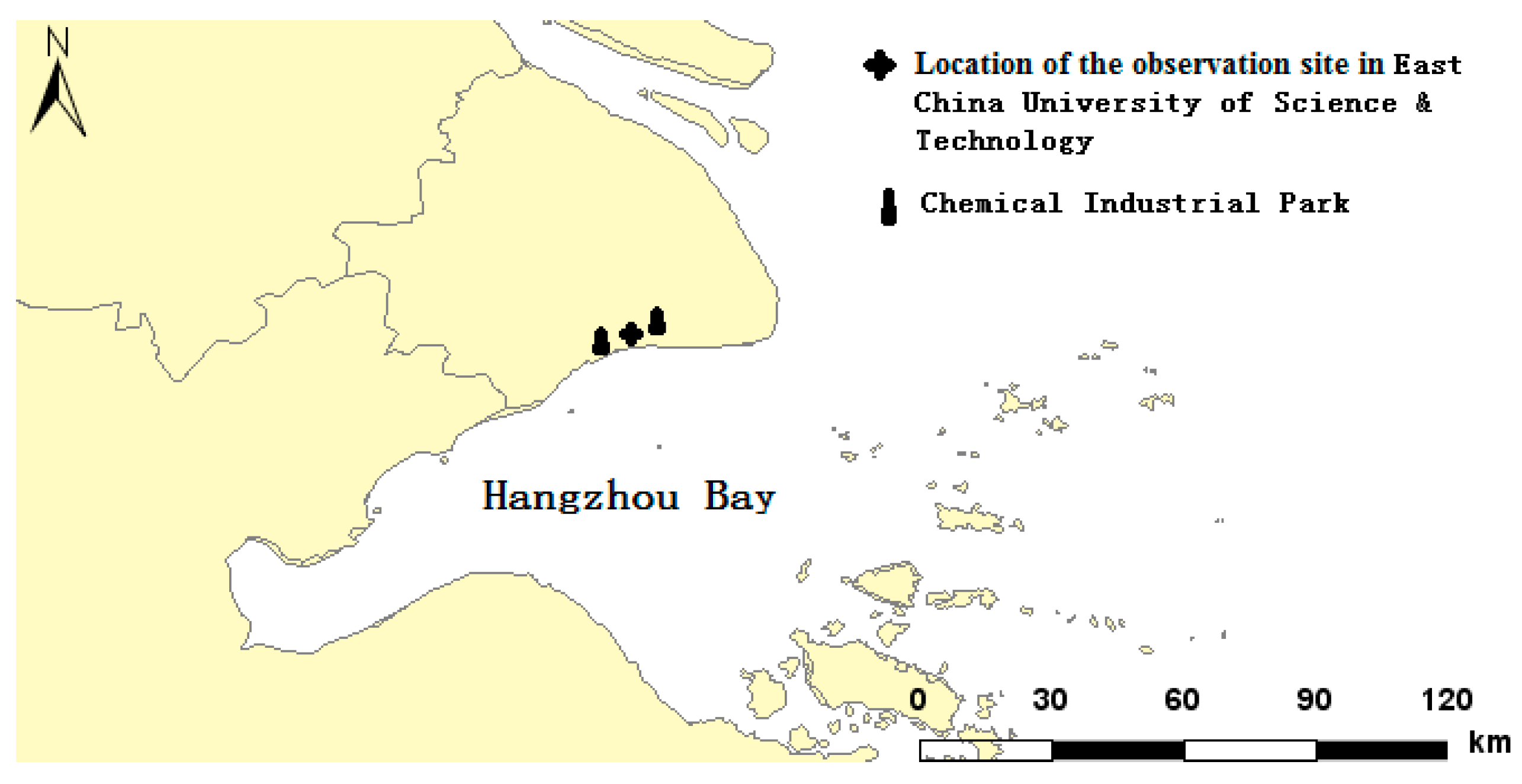
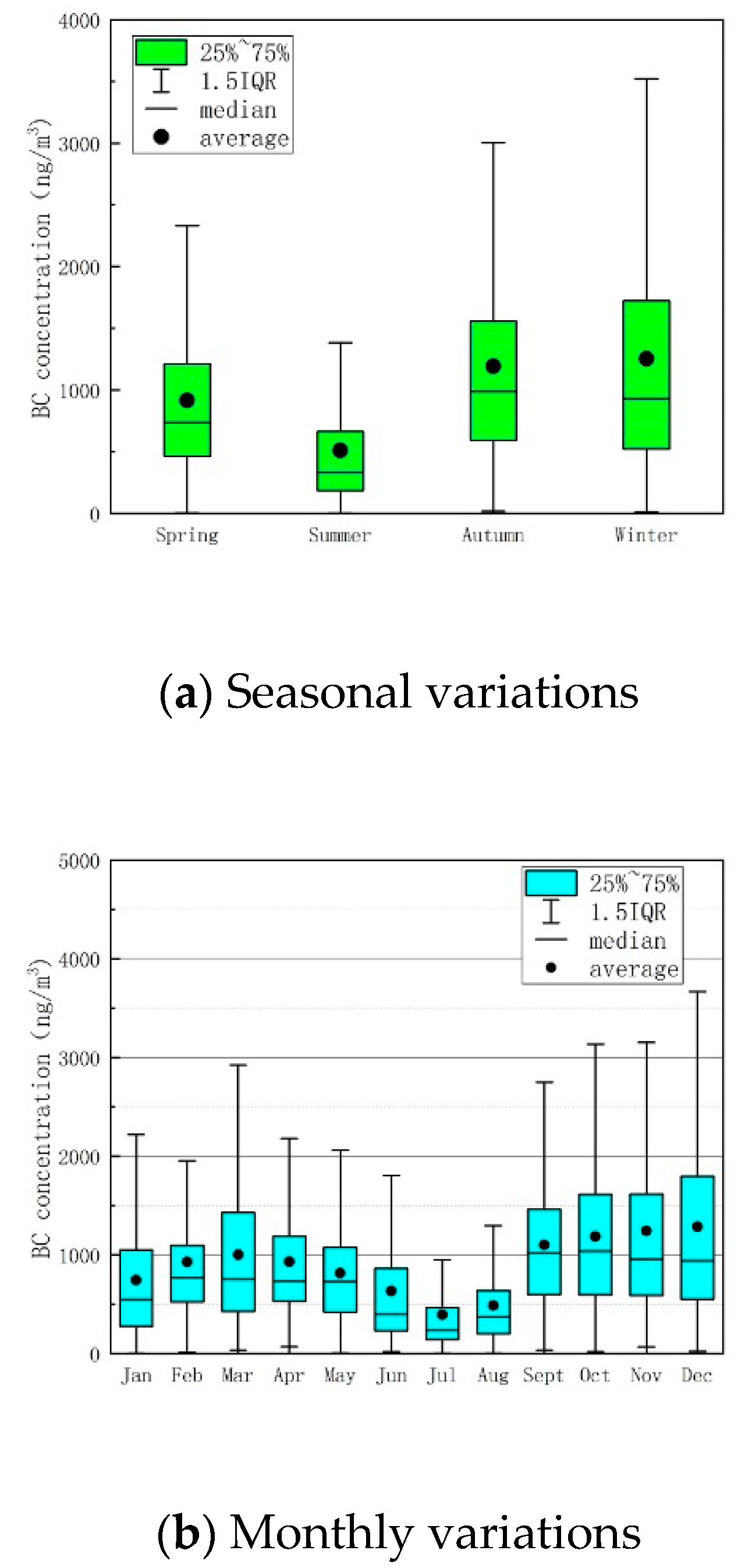
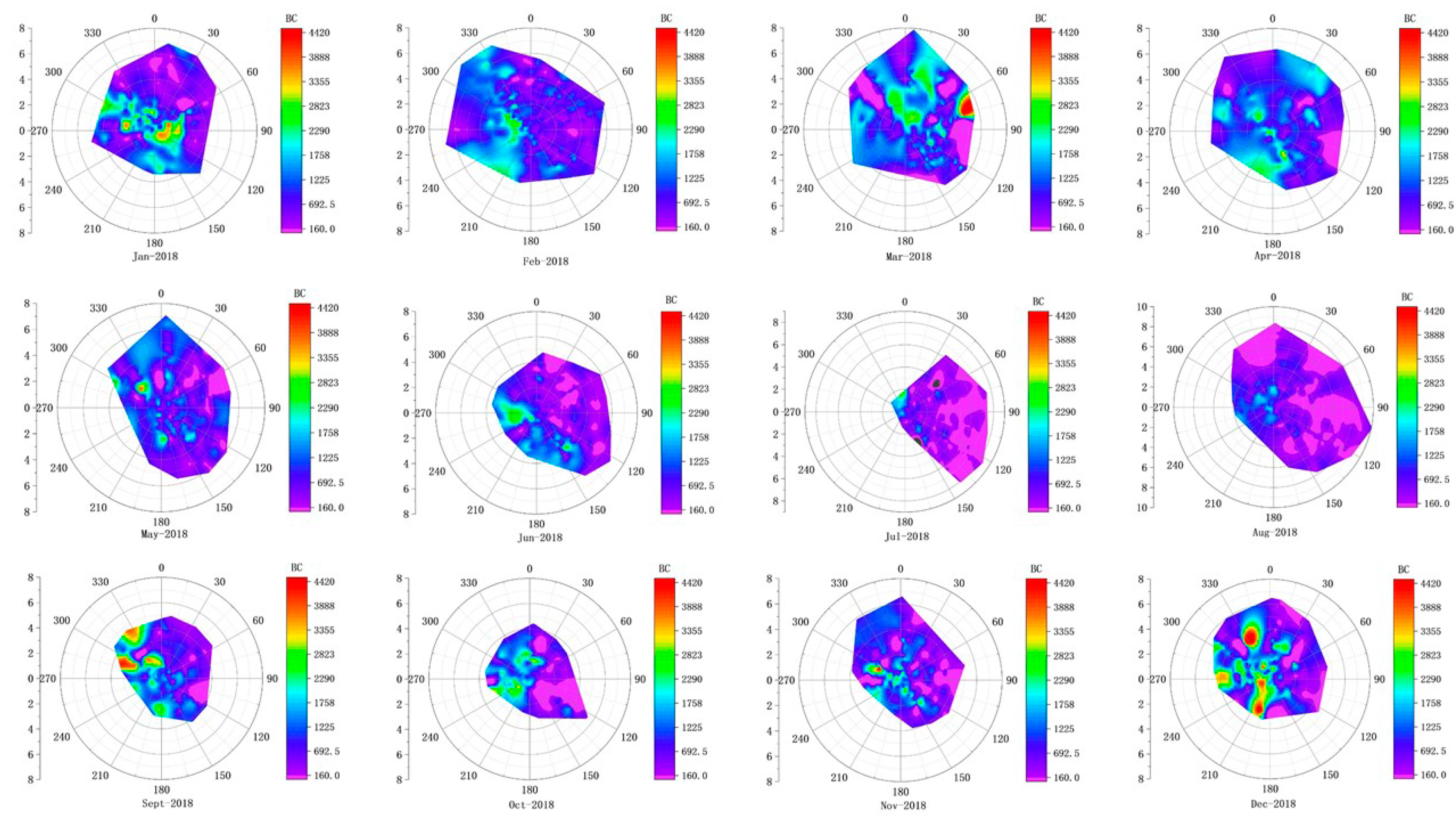
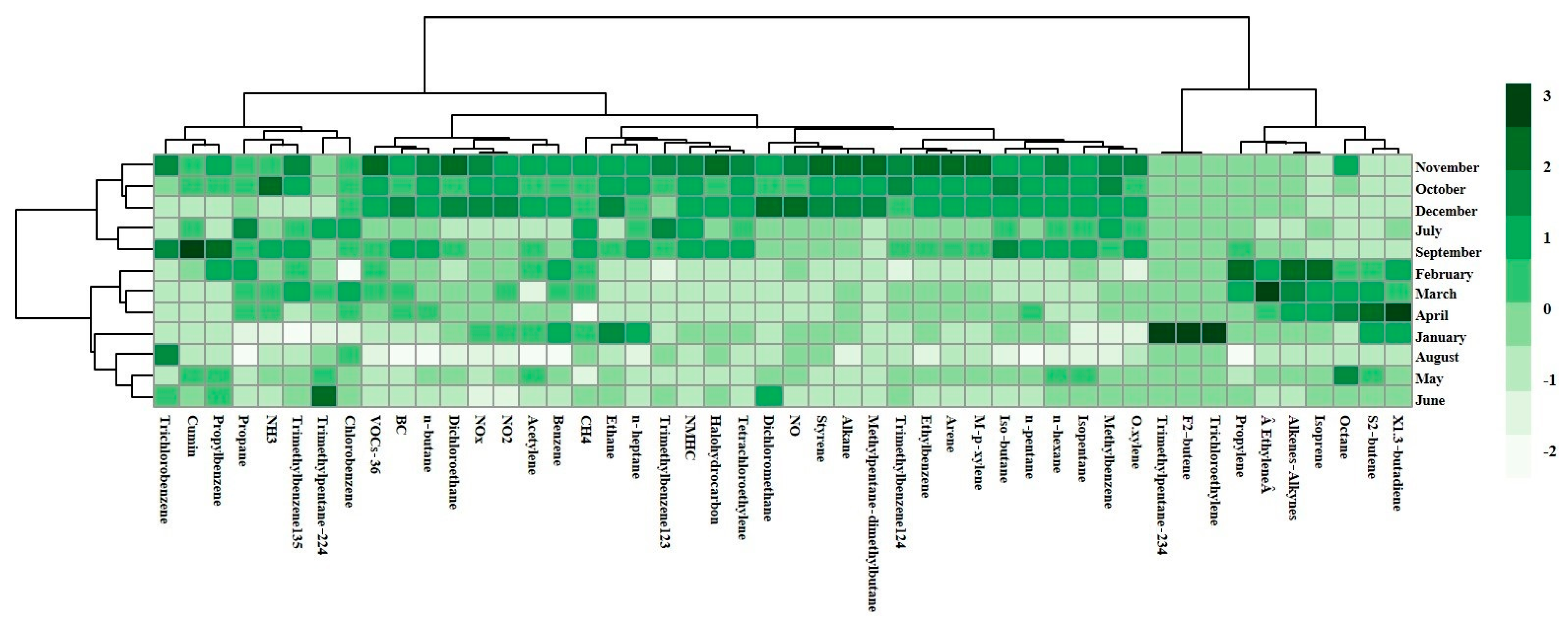

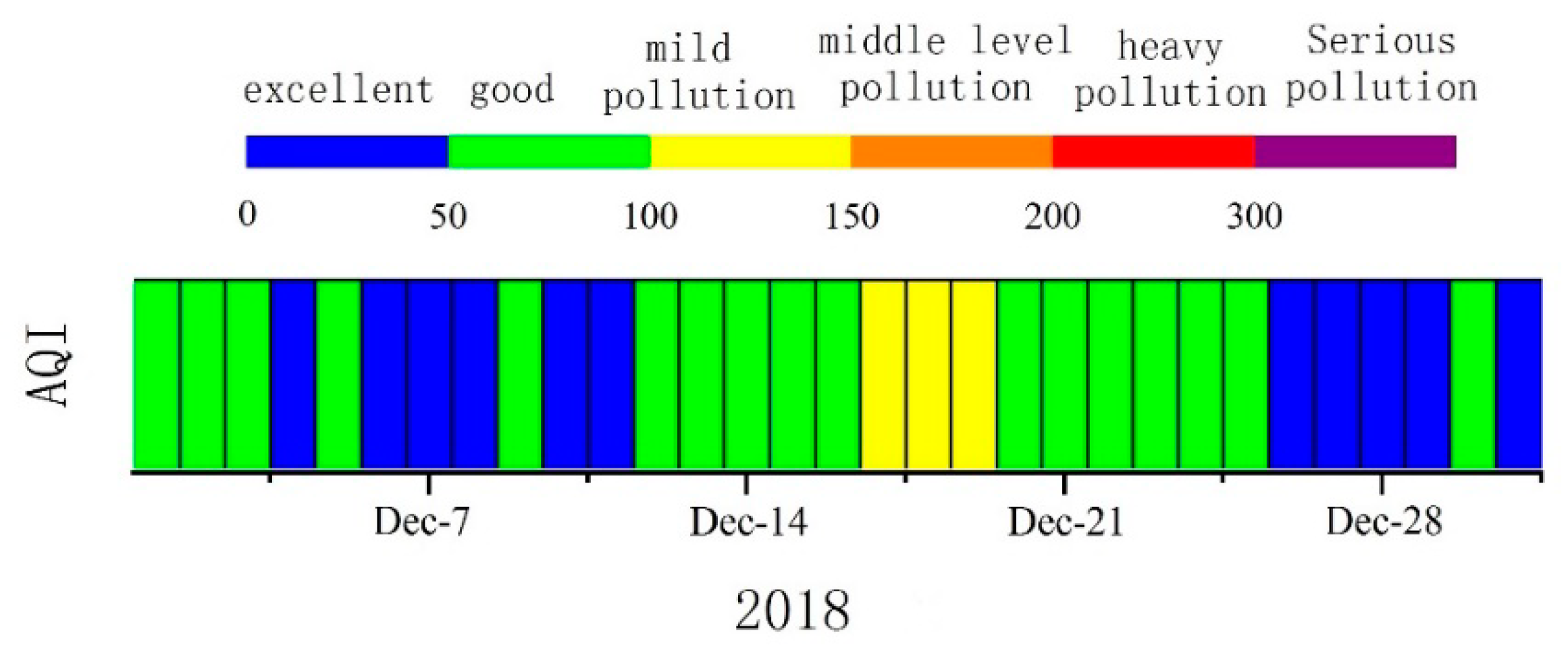
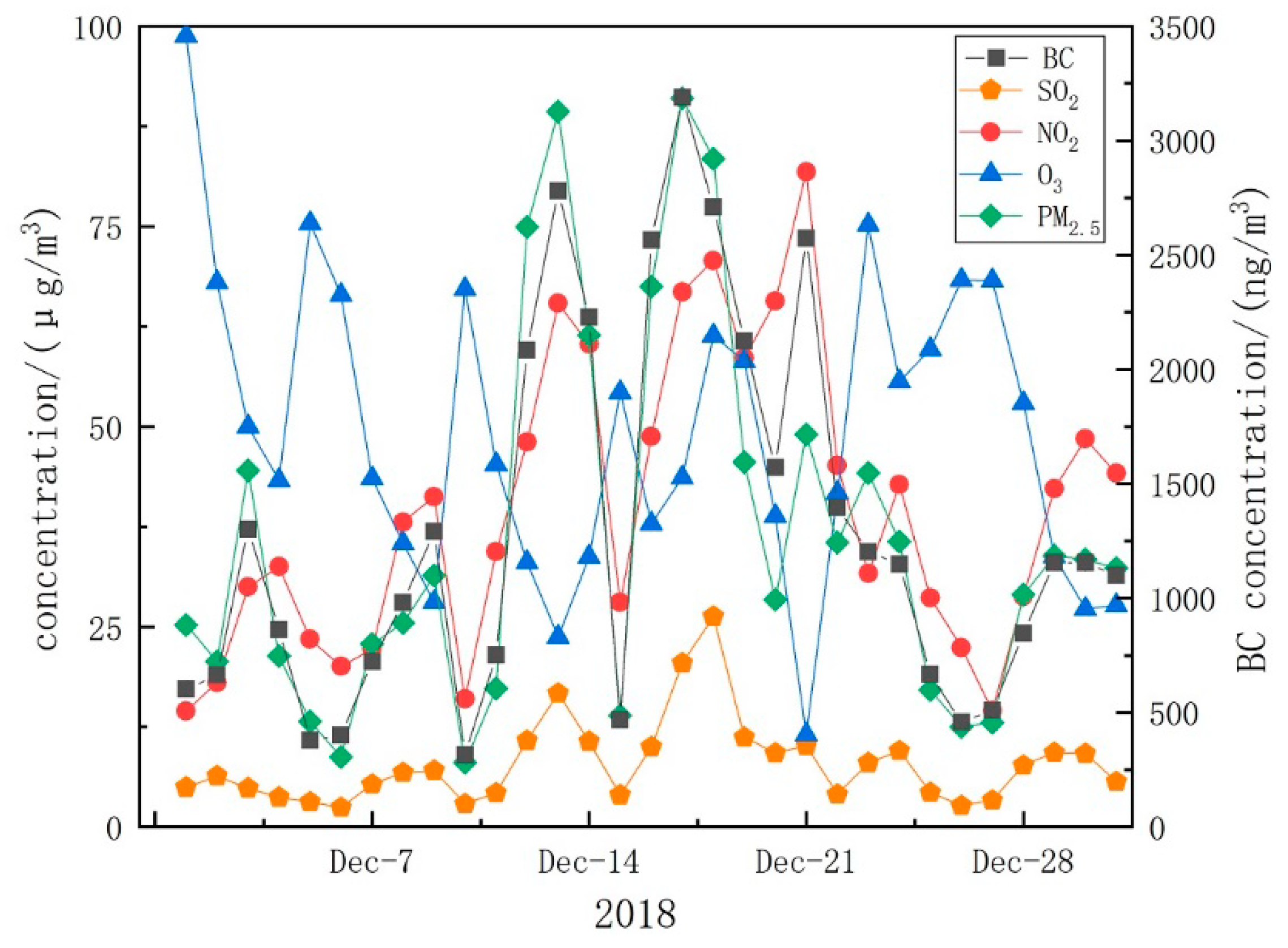
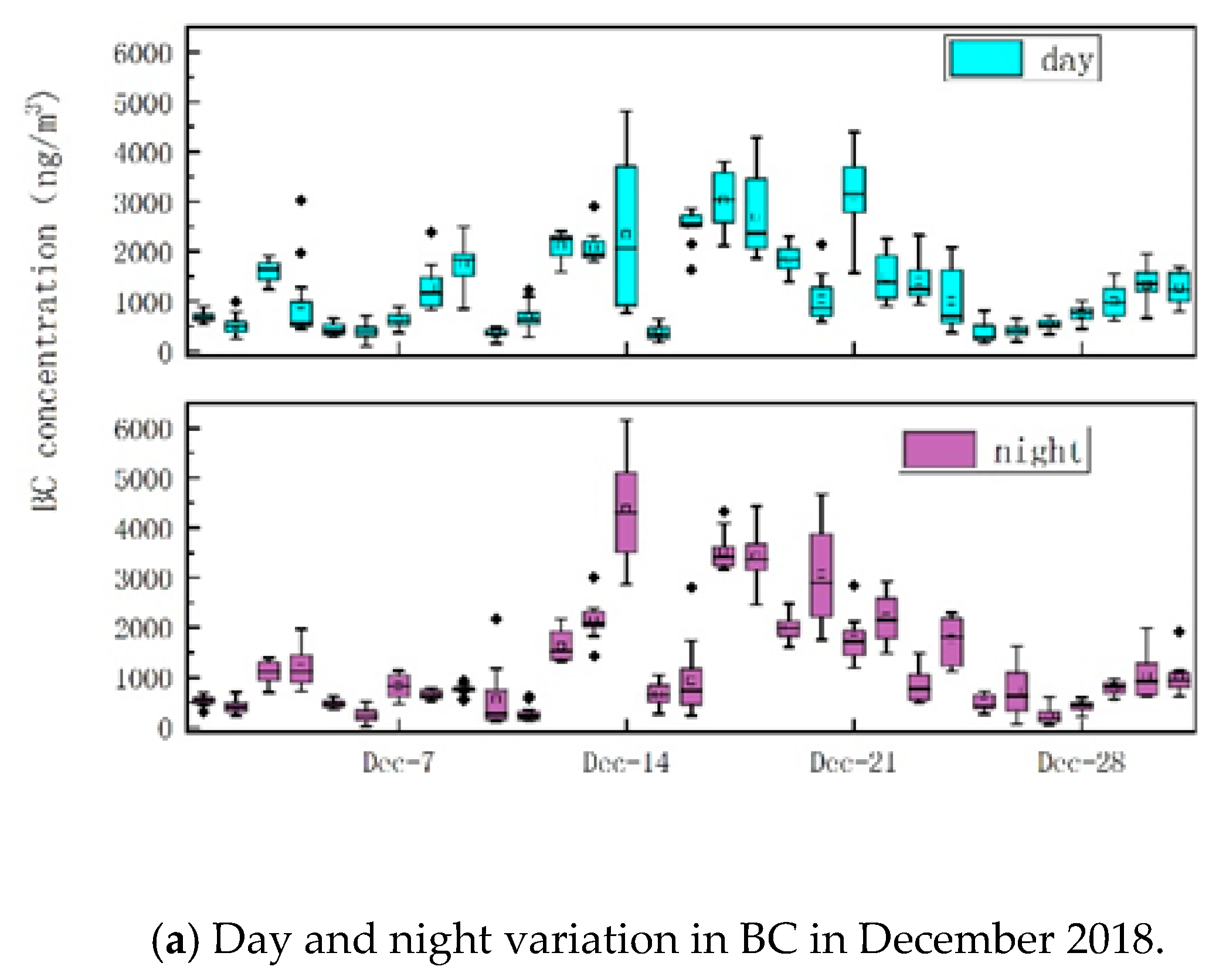
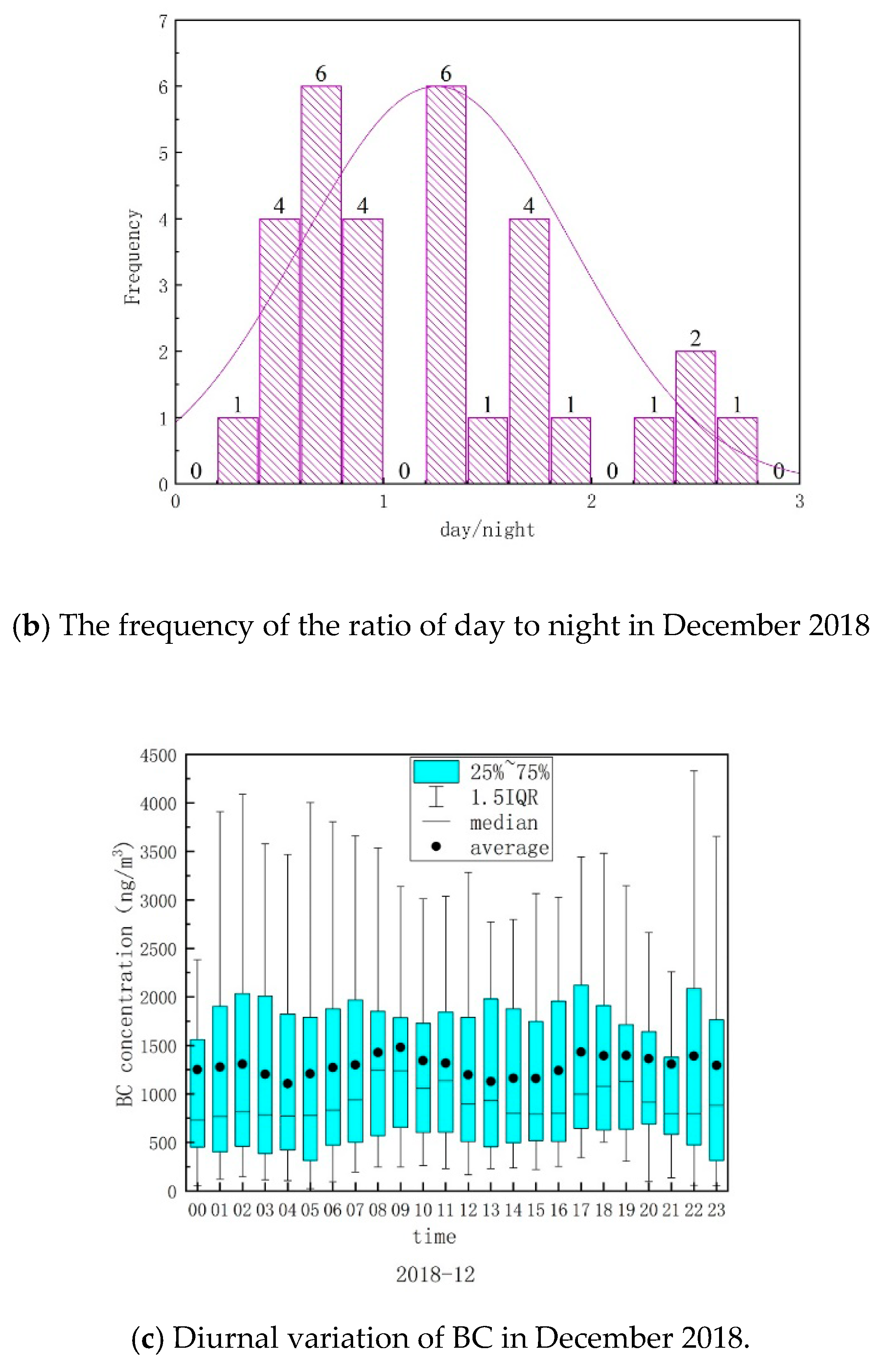

| No. | Compounds | 24-H | Rush Hour |
|---|---|---|---|
| 1 | Ethane | 0.777 | 0.746 |
| 2 | Propane | 0.801 | 0.805 |
| 3 | n-Butane | 0.732 | 0.713 |
| 4 | Iso-butane | 0.668 | 0.639 |
| 5 | n-Pentane | 0.752 | 0.716 |
| 6 | Isopentane | 0.676 | 0.612 |
| 7 | n-Hexane | 0.475 | 0.425 |
| 8 | n-Heptane | 0.364 | 0.254 |
| 9 | Octane | 0.371 | 0.491 |
| 10 | 2,2,4-Trimethylpentane | 0.149 | 0.144 |
| 11 | 2,3,4-Trimethylpentane | 0.506 | 0.383 |
| 12 | Ethylene | 0.602 | 0.572 |
| 13 | Acetylene | 0.852 | 0.898 |
| 14 | Propylene | 0.43 | 0.485 |
| 15 | cis-2-Butene | —— | —— |
| 16 | trans-2-Butene | —— | —— |
| 17 | 1,3-Butadiene | 0.0764 | −0.0458 |
| 18 | Isoprene | 0.128 | 0.191 |
| 19 | Benzene | 0.451 | 0.337 |
| 20 | Toluene | 0.46 | 0.424 |
| 21 | Ethylbenzene | 0.666 | 0.597 |
| 22 | o-Xylene | 0.574 | 0.493 |
| 23 | m-Xylene + p-Xylene | 0.562 | 0.464 |
| 24 | Styrene | 0.184 | 0.362 |
| 25 | 1,2,3-Trimethylbenzene | 0.708 | 0.656 |
| 26 | 1,2,4-Trimethylbenzene | 0.702 | 0.661 |
| 27 | 1,3,5-Trimethylbenzene | 0.621 | 0.65 |
| 28 | Cumene | 0.325 | 0.302 |
| 29 | Propylbenzene | 0.701 | 0.693 |
| 30 | Dichloromethane | 0.225 | 0.18 |
| 31 | 1,2-Dichloroethane | 0.319 | 0.237 |
| 32 | Trichloroethylene | —— | —— |
| 33 | Tetrachloroethylene | 0.446 | 0.369 |
| 34 | Chlorobenzene | 0.236 | 0.217 |
| 35 | 1,2,4-Trichlorobenzene | −0.0111 | 0.0268 |
| 36 | 2-Methylpentane + 2,3-Dimethylbutane | 0.587 | 0.583 |
Publisher’s Note: MDPI stays neutral with regard to jurisdictional claims in published maps and institutional affiliations. |
© 2021 by the authors. Licensee MDPI, Basel, Switzerland. This article is an open access article distributed under the terms and conditions of the Creative Commons Attribution (CC BY) license (https://creativecommons.org/licenses/by/4.0/).
Share and Cite
Wang, F.; Xu, J.; Huang, Y.; Xiu, G. Characterization of Black Carbon and Its Correlations with VOCs in the Northern Region of Hangzhou Bay in Shanghai, China. Atmosphere 2021, 12, 870. https://doi.org/10.3390/atmos12070870
Wang F, Xu J, Huang Y, Xiu G. Characterization of Black Carbon and Its Correlations with VOCs in the Northern Region of Hangzhou Bay in Shanghai, China. Atmosphere. 2021; 12(7):870. https://doi.org/10.3390/atmos12070870
Chicago/Turabian StyleWang, Fangfang, Jialuo Xu, Yinzhi Huang, and Guangli Xiu. 2021. "Characterization of Black Carbon and Its Correlations with VOCs in the Northern Region of Hangzhou Bay in Shanghai, China" Atmosphere 12, no. 7: 870. https://doi.org/10.3390/atmos12070870





